Black Spider With 4 White Dots on Back
ENTFACT SUPPLEMENT: Urban Spider Chart
by Blake Newton and Lee Townsend, Extension Entomology
University of Kentucky College of Agriculture
The majority of Kentucky's spiders are harmless to humans, even when they enter our living environments. This chart is designed to help with quick identification of spiders that are commonly encountered in homes, buildings, yards, and other urban environments. Click on the spider to read more about it.
Spiders of Medical Significance
Other Common Kentucky Spiders
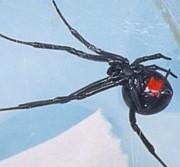 Black Widow Spider
Black Widow Spider
Black Widow
Size: Adult female is about 1/2 inch long.
Color: Adult females are glossy black with a variable number of red markings on the top and bottom of abdomen. Adults males are similar, but with a few white markings. Juveniles are highly variable.
Features: Abdomen is nearly spherical on adult females and juveniles. Male is slimmer with longer legs (pictured here).
Notes: Bites are very serious and require immediate medical attention, but the spider is timid and unlikely to bite unless handled. Black widows are common all over Kentucky. They tend to occur in concealed outdoor locations: piles of rocks, piles of firewood, and dark corners of garages and out-buildings. Females are common; males are very rarely encountered.
Read More: Eliminating Spiders Around Homes and Buildings (ENT-623)
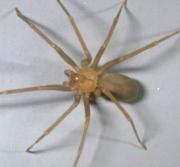 Brown Recluse Spider
Brown Recluse Spider
Brown Recluse
Size: About the size of a U.S. quarter, with legs outstretched.
Color: Tan to dark brown, abdomen and legs are uniformly colored with no stripes, bands, or mottling. The legs are long and thin and lack conspicuous spines.
Features: Dark violin-shaped mark on back, with the neck of the violin pointing toward the rear (abdomen) of the spider. This feature is consistent in adult brown recluses, but can be hard to see and is less obvious in younger spiders. Also, brown recluses only have six eyes: most Kentucky spiders have eight.
Notes: Bites are very serious and require immediate medical attention, but brown recluses are timid and unlikely to bite unless handled. These spiders are more common in Western KY, less common in Central and Southeastern KY. They tend to occur in hidden locations indoors and outdoors: piles of cardboard or paper, stacks of cut wood, and wall-voids of buildings.
Read More: Brown Recluse Spider (ENT-631)
 Grass Spider
Grass Spider
Grass Spider
Size: About the size of a U.S. quarter, with legs outstretched.
Color: Brown with prominent longitudinal gray or tan stripes.
Features: Prominent hind spinnerets: these are two, small, finger-like projections on the end of the grass spider's abdomen (used to spin the web). Many other spiders have spinnerets, but they are very large and distinctive in grass spiders.
Notes: Grass spiders are very common in Kentucky lawns where they build large, funnel-shaped webs. They also occasionally wander into homes. Because they are brown and of a similar size, grass spiders are often mistaken for brown recluses. Like most Kentucky spiders, though, the bites of grass spiders are harmless except to allergic individuals.
Read More: Eliminating Spiders Around Homes and Buildings (ENT-623), Kentucky Spiders: Grass Spiders
Wolf Spiders
Size: Wolf spiders range in size from tiny (the size of a pencil eraser) to about the size of a U.S. silver dollar, with legs outstretched
Color: There are many species of wolf spiders in Kentucky, but most are dark or light brown, usually with contrasting spots or stripes.
Features: Wolf spiders are fast-moving and they are typically seen running on the ground. They are not web builders.
Notes: Wolf spiders often wander into homes. Because they are brown in color, wolf spiders are often mistaken for brown recluses. Like most Kentucky spiders, the bites of wolf spiders are harmless except to allergic individuals. Wolf spiders are among the most common kinds of spiders in Kentucky.
Read More:Eliminating Spiders Around Homes and Buildings (ENT-623), Kentucky Spiders: Wolf Spiders
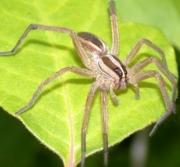 Rabid Wolf Spider
Rabid Wolf Spider
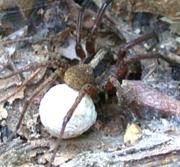 Schizocosa Wolf Spider
Schizocosa Wolf Spider
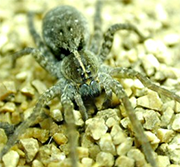 Hogna Wolf Spider
Hogna Wolf Spider
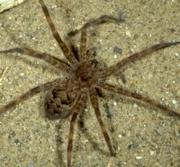 Fishing Spider
Fishing Spider
Fishing Spider
Size: A little larger than a U.S. silver dollar, with legs outstretched.
Color: Brown with contrasting, darker brown patterns.
Features: Very large brown spiders; sometimes seen running on the ground or sitting motionless on tree trunks.
Notes: Fishing spiders are common near streams and wooded areas in Kentucky, and they sometimes wander into nearby homes. They are among the largest spiders in our state, but they are not considered dangerous. Like most Kentucky spiders, the bites of fishing spiders are harmless except to allergic individuals. They are sometimes mistaken for brown recluse spiders, but adult brown recluses are smaller and lack the fishing spider's distinct dark brown patterning.
Read More:Eliminating Spiders Around Homes and Buildings (ENT-623), Kentucky Spiders: Fishing Spiders
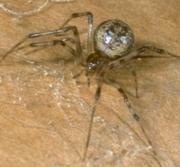 American House Spider
American House Spider
American House Spider
Size: About the size of a U.S. nickel, with legs outstretched.
Color: Brown and tan highlighted with dark brown patterns
Features: Spherical abdomen; almost always encountered in its compact, messy cobweb
Notes: The American House Spider is one of the most commonly encountered spiders in Kentucky and is found in many homes and buildings. Because it is brown in color, American house spiders are often mistaken for brown recluses. Unlike brown recluses, though, house spiders are almost never found outside of their webs. Like most Kentucky spiders, the bites of house spiders are harmless except to allergic individuals. The American House Spider is a type of cobweb spider.
Read More: Eliminating Spiders Around Homes and Buildings (ENT-623), Kentucky Spiders: Cobweb Spiders
 Cellar Spider
Cellar Spider
Cellar Spider
Size: About the size of a U.S. half-dollar, with legs outstretched.
Color: Light tan or gray with darker contrasting markings.
Features: Small, thin body with long, thin legs; almost always encountered in its messy cobweb.
Notes: Cellar spiders are among the most commonly encountered spiders in Kentucky and they are found in many homes and buildings. Because it is brownish in color, cellar spiders are often mistaken for brown recluses, but cellar spiders have much longer and thinner legs than brown recluses. Like most Kentucky spiders, the bites of cellar spiders are harmless except to allergic individuals. Cellar spiders are sometimes called "daddy-long-legs" or "granddaddy-long-legs," but they are not closely related to harvestmen (which are not true spiders), which are also known as daddy-long-legs.
Read More: Eliminating Spiders Around Homes and Buildings (ENT-623), Kentucky Spiders: Cellar Spiders
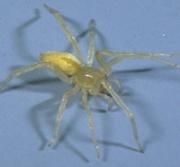 Yellow Sac Spider
Yellow Sac Spider
Yellow Sac Spider
Size: About the size of a U.S. nickel, with legs outstretched.
Color: Tan legs and head, yellow abdomen
Features: Low, flat spider; does not build a web
Notes: The yellow sac spider is commonly found in homes and it is often mistaken for the brown recluse because it is similar in shape, but the yellow sac spider lacks the "fiddle" pattern of the brown recluse. Also, the sac spider has eight eyes instead of six. The bite of a yellow sac spider can be painful, but it is not medically significant except to allergic individuals.
Read More: Eliminating Spiders Around Homes and Buildings (ENT-623)
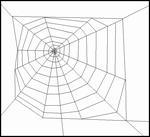 Typical Orb Web
Typical Orb Web
Orb Weavers
Size: Orb weavers range in size from tiny (the size of a pencil eraser) to a little larger than a U.S. silver dollar, with legs outstretched.
Color: There are many species of orb-weaver spiders in Kentucky. Some are solid tan or brown, while others are colorful with vivid patterns.
Features: Orb weavers are distinguished by their webs: no other common Kentucky spiders make organized, circular, grid-like webs. Orb weavers are almost always encountered inside their webs.
Notes: Orb weavers are commonly found on porches and gardens in Kentucky, especially in late summer. Occasionally, they will wander into a home and build a web in a doorway or windowsill. Some orb weavers are very large, but, like most Kentucky spiders, the bites of orb weavers are harmless except to allergic individuals. The Yellow-and-black Argiope (pictured below, top left), one of the largest spiders in Kentucky, is a type of orb weaver.
Read More: Eliminating Spiders Around Homes and Buildings (ENT-623), Kentucky Spiders: Orb Weavers
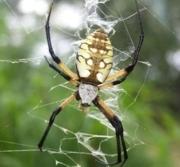 Argiope Orb Weaver
Argiope Orb Weaver
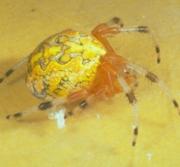 Marbled Spider
Marbled Spider
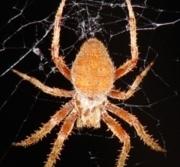 Spotted Orb Weaver (top)
Spotted Orb Weaver (top)
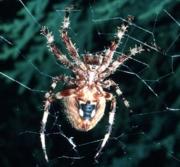 Spotted Orb Weaver (bottom)
Spotted Orb Weaver (bottom)
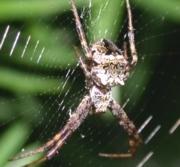 Star-Bellied Spider
Star-Bellied Spider
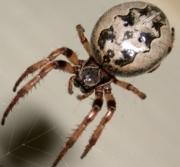 Furrow Spider
Furrow Spider
 Micrathena Orb Weaver
Micrathena Orb Weaver
Jumping Spiders
Size: Typical jumping spiders are about the size of a U.S. dime, with legs outstretched.
Color: There are many species of jumping spiders in Kentucky. Many are gray or black, while some are vividly colored.
Features: Jumping spiders have distinctive, large eyes and a "flat faced" look. They are characterized by quick, herky-jerky motions and they do not build webs.
Notes: Jumping spiders are common on the outsides of homes and buildings and they often wander into homes. Because some are brown in color, jumping spiders are sometimes mistaken for brown recluses. Like most Kentucky spiders, though, the bites of jumping spiders are harmless except to allergic individuals.
Read More: Eliminating Spiders Around Homes and Buildings (ENT-623), Kentucky Spiders: Jumping Spiders
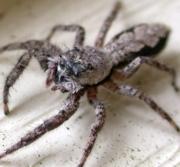 Jumping Spider
Jumping Spider
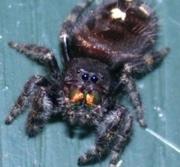 Bold Jumping Spider
Bold Jumping Spider
 Woodlouse Hunter
Woodlouse Hunter
Woodlouse Hunter
Size: About the size of a U.S. nickel, with legs outstretched.
Color: Dark, reddish-brown head, gray abdomen, orange legs.
Features: Woodlouse hunters are distinguished by their very large fangs and low, flat shape. They are not web-builders.
Notes: Woodlouse hunters are often found outdoors under rocks and logs near buildings where they hunt for woodlice (a.k.a. roly-polies or pillbugs) and they sometimes wander into homes. Because these spiders are brownish in color and similar in size, they are occasionally mistaken for brown recluses. Like most Kentucky spiders though, the bites of woodlouse hunters are harmless except to allergic individuals, despite their large fangs.
Read More: Eliminating Spiders Around Homes and Buildings (ENT-623)
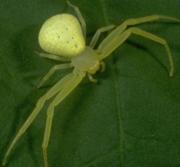 Crab Spider
Crab Spider
Crab Spiders
Size:Typical crab spiders are about the size of a U.S. nickel, with legs outstretched.
Color: There are many species of crab spiders in Kentucky. Some are brown or tan, but most common species are bright white or vivid "neon" green or yellow.
Features: Crab spiders are low and flat and their front two pairs of legs are very long. Crab spiders are not web builders.
Notes: Crab spiders are very common in Kentucky flowers (where they hunt for bees), but they sometimes wander into homes. Because some crab spiders are brown in color, they are occasionally mistaken for brown recluses. Like most Kentucky spiders, the bites of crab spiders are harmless except to allergic individuals.
Read More: Eliminating Spiders Around Homes and Buildings (ENT-623), Kentucky Spiders: Crab Spiders
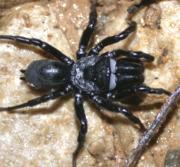 Purseweb Spider
Purseweb Spider
Purseweb Spiders
Size:Purseweb spiders are about the size of a U.S. half-dollar, with legs outstretched.
Color: Shiny black; some have white marks behind the fangs.
Features: Purseweb spiders are large spiders with low, flat bodies.
Notes: Purseweb spiders are common in Kentucky forests. Their webs are hidden, so they are rarely seen. Males, however, are sometimes found wandering on roads and sidewalks in the spring. These spiders are almost never found in homes. Because of their shiny, black color, they are occasionally mistaken for black widows. Purseweb spiders are larger than black widows, though, and lack red markings. Like most Kentucky spiders, the bites of purseweb spiders are harmless except to allergic individuals.
Read More: Eliminating Spiders Around Homes and Buildings (ENT-623), Kentucky Spiders: Purseweb Spiders
Issued: 1/10
CAUTION! Pesticide recommendations in this publication are registered for use in Kentucky, USA ONLY! The use of some products may not be legal in your state or country. Please check with your local county agent or regulatory official before using any pesticide mentioned in this publication.
Of course,ALWAYS READ AND FOLLOW LABEL DIRECTIONS FOR SAFE USE OF ANY PESTICIDE!
Photos courtesy University of Kentucky Entomology, except Orb Weaver #3 by F. Fahmy, Orb Weaver #4 by Jim Occi, BugPics, Orb Weaver #5 by Karan A. Rawlins, UGA, and Woodlouse Hunter by Joseph Berger, UGA
Black Spider With 4 White Dots on Back
Source: https://entomology.ca.uky.edu/spider-chart